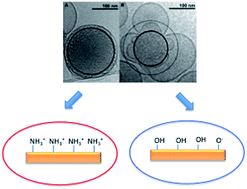Structural effects of the dispersing agent polysorbate 80 on liquid crystalline nanoparticles of soy phosphatidylcholine and glycerol dioleate†
Abstract
Well-defined, stable and highly structured I2 (Fd![[3 with combining macron]](https://www.rsc.org/images/entities/char_0033_0304.gif) m) liquid crystalline nanoparticles (LCNP) of 50/50 (wt/wt) soy phosphatidylcholine (SPC)/glycerol dioleate (GDO), can be formed by using a low fraction (5–10 wt%) of the dispersing polymeric surfactant polyoxyethylene (20) sorbitan monooleate (polysorbate 80 or P80). In the present study we used small angle neutron scattering (SANS) and deuterated P80 (d-P80) to determine the location and concentration of P80 within the LCNP and small angle X-ray scattering (SAXS) to reveal the internal structure. SANS data suggests that some d-P80 already penetrates the particle core at 5%. However, the content of d-P80 is still low enough not to significantly change the internal Fd
m) liquid crystalline nanoparticles (LCNP) of 50/50 (wt/wt) soy phosphatidylcholine (SPC)/glycerol dioleate (GDO), can be formed by using a low fraction (5–10 wt%) of the dispersing polymeric surfactant polyoxyethylene (20) sorbitan monooleate (polysorbate 80 or P80). In the present study we used small angle neutron scattering (SANS) and deuterated P80 (d-P80) to determine the location and concentration of P80 within the LCNP and small angle X-ray scattering (SAXS) to reveal the internal structure. SANS data suggests that some d-P80 already penetrates the particle core at 5%. However, the content of d-P80 is still low enough not to significantly change the internal Fd![[3 with combining macron]](https://www.rsc.org/images/entities/char_0033_0304.gif) m structure of the LCNP. At higher fractions of P80 a phase separation occurs, in which a SPC and P80 rich phase is formed at the particle surface. The surface layer becomes gradually richer in both solvent and d-P80 when the surfactant concentration is increased from 5 to 15%, while the core of the particle is enriched by GDO, resulting in loss of internal structure and reduced hydration. We have used neutron reflectometry to reveal the location of the stabiliser within the adsorbed layer on an anionic silica and cationic (aminopropyltriethoxysilane (APTES) silanized) surface. d-P80 is enriched closest to the supporting surface and slightly more so for the cationic APTES surface. The results are relevant not only for the capability of LCNPs as drug delivery vehicles but also as means of preparing functional surface coatings.
m structure of the LCNP. At higher fractions of P80 a phase separation occurs, in which a SPC and P80 rich phase is formed at the particle surface. The surface layer becomes gradually richer in both solvent and d-P80 when the surfactant concentration is increased from 5 to 15%, while the core of the particle is enriched by GDO, resulting in loss of internal structure and reduced hydration. We have used neutron reflectometry to reveal the location of the stabiliser within the adsorbed layer on an anionic silica and cationic (aminopropyltriethoxysilane (APTES) silanized) surface. d-P80 is enriched closest to the supporting surface and slightly more so for the cationic APTES surface. The results are relevant not only for the capability of LCNPs as drug delivery vehicles but also as means of preparing functional surface coatings.


 Please wait while we load your content...
Please wait while we load your content...